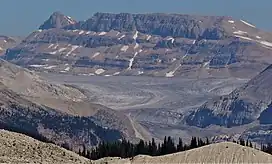Mount Rhondda
Mount Rhondda is located on the Continental Divide straddling the Canadian provinces of Alberta and British Columbia. It was named in 1917 by the Interprovincial Boundary Survey after David Alfred Thomas, First Viscount Baron Rhondda.[5][1]
| Mount Rhondda | |
|---|---|
 Mount Rhondda seen with Yoho Glacier from Iceline Trail | |
| Highest point | |
| Elevation | 3,062 m (10,046 ft)[1][2] |
| Prominence | 102 m (335 ft)[1] |
| Parent peak | Mount Habel (3087 m)[1] |
| Listing | |
| Coordinates | 51°38′36″N 116°33′40″W[3] |
| Geography | |
 Mount Rhondda Location in Alberta and British Columbia  Mount Rhondda Mount Rhondda (Canada) | |
| Country | Canada |
| Provinces | |
| Parent range | Waputik Mountains |
| Topo map | NTS 82N10 Blaeberry River[3] |
| Climbing | |
| First ascent | 1923 A. Geoffrion, J.W.A. Hickson, Edward Feuz Jr.[4][1][5] |
First Ascent
Mt. Rhondda was first climbed in August 1923 by A. Geoffrion, J.W.A. Hickson and Edward Feuz Jr. The party's original intent was the FA of Mount Baker but early on in the ascent they discovered tracks from a different party (Walter Wilcox and Rudolf Aemmer) heading towards Mt. Baker. They decided to continue onto the col between the two peaks where they spotted snow tracks and cairn on the summit rocks of Mt. Baker. With Baker claimed, they turned their attention to Mt. Rhondda which they summitted in the early afternoon after ascending mixed terrain of rock and snow.[4]
Geology
Mount Rhondda is composed of sedimentary rock laid down during the Precambrian to Jurassic periods.[6] Formed in shallow seas, this sedimentary rock was pushed east and over the top of younger rock during the Laramide orogeny.[7]
Climate
Based on the Köppen climate classification, Mount Rhondda is located in a subarctic climate with cold, snowy winters, and mild summers.[8] Temperatures can drop below −20 °C (−4 °F) with wind chill factors below −30 °C (−22 °F).
References
- "Mount Rhondda". Bivouac.com. Retrieved 2019-07-12.
- "Topographic map of Mount Rhondda". opentopomap.org. Retrieved 2021-10-31.
- "Mount Rhondda". Geographical Names Data Base. Natural Resources Canada. Retrieved 2019-07-12.
- Hickson, J.W.A (1924). "Around Bow Pass, The Saskatchewan River And Cathedral Crags". Mountaineering Section. Canadian Alpine Journal. Alpine Club of Canada: 8–10. Retrieved 2019-07-28.
- "Mount Rhondda". cdnrockiesdatabases.ca. Retrieved 2019-07-12.
- Belyea, Helen R. (1960). The Story of the Mountains in Banff National Park (PDF). parkscanadahistory.com (Report). Ottawa: Geological Survey of Canada. Archived (PDF) from the original on 2015-10-02. Retrieved 2019-09-13.
- Gadd, Ben (2008). Geology of the Rocky Mountains and Columbias.
- Peel, M. C.; Finlayson, B. L.; McMahon, T. A. (2007). "Updated world map of the Köppen−Geiger climate classification". Hydrol. Earth Syst. Sci. 11: 1633–1644. ISSN 1027-5606.
External links
- Mt. Rhondda photo: Flickr